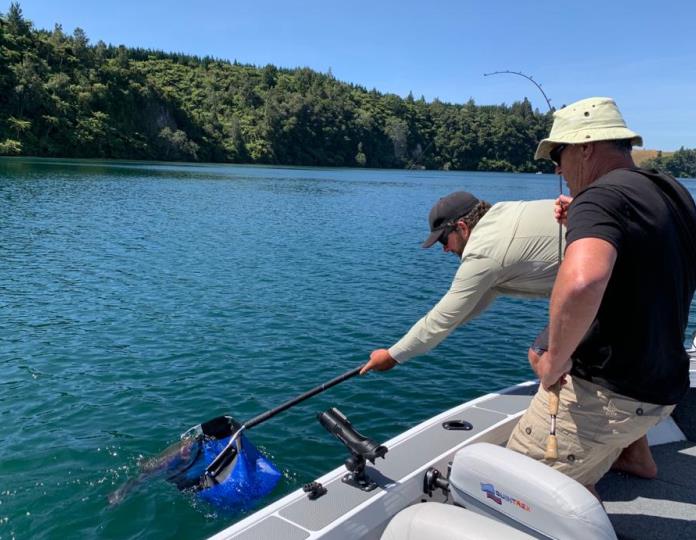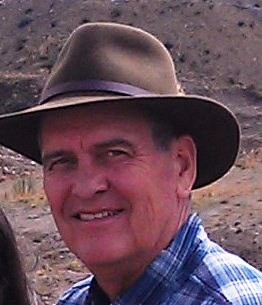How to find them
In February 2020, I fulfilled a life-long dream of fishing a fabled trout lake in New Zealand. My buddy Roy and I booked a charter boat on Lake Rotoiti.

It was all I had ever dreamed. Our guide, Trent, took us out on a sunny afternoon in his sleek Australian Quintrex and supplied us with expert coaching and state-of-the-art gear.
The gear included a fish finder that I believe was designed by NASA. It could spot every fish in the water by depth, size, weight and Social Security number.
Understand, Rotoiti is a deep lake. The fish we were after live between 60 and 200 feet. No worries, though, Trent supplies color-coded fishing line to go with his laser guided fish finder. You let out just the right amount so you can dangle your bait smack in front of the trout’s nose.
Trent could see the fish so well he could even tell us (although he didn’t always) when one was about to strike. Roy and I had to learn how to react to their overtures before we could actually hook one, and that took a bit of time. Nevertheless, we landed six rainbows in the space of a couple hours and took home three in the 7-10 pound slot, enough to stroke our fishermen egos, impress the wives and send a few choice Facebook photos around the globe.
If you have yet to fulfill a life-long dream to fish trout in New Zealand, I should mention that professional charters there don’t come cheap. But you only go ‘round once, right? So even though Roy and I are frugal missionary types, we cheerfully shelled out a hefty sum to hire Trent, his sleek Quintrex and state-of-the-art gear.
Understand, we didn’t tell the wives until after it was a done deal. And because we now live seven thousand miles apart on opposite sides of the International Dateline, Roy and I will probably not be going ‘round on Rotoiti again in this life. It was well worth the investment.


When Roy and I fished trout together in Bolivia, we never used fish finders. One, because they hadn’t been invented yet (Roy and I go back a long way). Two, because in those days it was hard enough to find the water, let alone the fish.
In 1981, my friend Jack, with whom I go back even longer, moved his family to Bolivia. This was a few weeks before Barbara and I arrived in the country. A few weeks after that, a friend invited Jack to go trout fishing and Jack invited me to go along.
At the time, I was not even aware that Bolivia had trout. It would require several trips with Jack before I finally proved that indeed it does have them. That first trip we caught nothing, mainly because we were ill-prepared. Here’s a tip. Despite what some experienced anglers may tell you, it’s impossible to catch Andes trout on cheese, crackers and baloney. Jack and I were obliged to invest in proper tackle.
We also researched how to find productive trout water. Our investigations did not involve sportsmen magazines or cable fishing channels or even a book on Bolivia trout fishing, which I believe has yet to be written. It was strictly word of mouth. Whenever we came across a fellow fisherman--and they were few and far between in those days--we pumped him for information. Once we had a faint idea of where we might find a trout stream, we headed off into the wild to try our luck.
We had precious little. It was not until our third or fourth trip and during a pouring rainstorm that I finally landed my first trout. The German brown would have gone a good six inches, if I had had the decency to measure it. I confess that I was not even sportsman enough to return the little guy to the stream. I had to show Jack, who had sensibly retreated to the shelter of our pickup when the downpour started and was in the midst of pondering whether this might be his last pursuit of the wily Andes trout.
But the sight of a real, live fish dangling from my hook energized us both. From then on, we were all in, pumping the occasional fellow fishermen for information and heading off into the wild at every chance. The more we pursued, the better water we found and the more luck we had. We eventually were bringing home enough fish to have a trout meal once in a while with our wives and kids. I think I even invited a friend over, once.
A little bit of context. Trout are not native to the Andes. As in many parts of the world, they were brought here by humans. Governments brought them to some countries; Bolivia’s government did not. It fell to the fishermen themselves to populate the streams and rivers.
Mike is one of those fishermen. He told me how, in the 1950s and 60s, he and a group of friends scouted out every viable trout stream in the department (the Bolivian name for “state”) of Cochabamba, and then placed orders for fertilized trout eggs to be delivered by plane. When the shipments arrived, they were waiting at the airport with their four-wheel drives to transport the eggs to distant streams to hatch.
There were still lots of trout in these streams when Jack, Roy and I began fishing in the 1980s. But then a drought cycle dried up rivers. Others were fouled by chemicals when highland farmers, campesinos in Spanish, switched from animal dung to commercial fertilizer. Many trout streams in Cochabamba department are now so degraded that no self-respecting trout would think of living in them.
Luckily the campesinos have discovered how to farm trout in highland lakes. They plant thousands of fingerlings and leave the little guys in there for two to three years to grow up. Then they net out the whole lot, sell them in the city and leave the lake alone a few years to replenish the food chain.
A few wily trout escape the nets and continue to grow. If nobody bothers them, they eventually get big enough to give an angler a proper thrill when they strike. That’s the reason I fish. At my advanced age, I need to keep my heart rate up and, as you know, nothing does that like a big trout striking your spinner bait.
All this makes me think about the debt I owe to all those fellow fishermen who told me what I needed to know in order to find these fish. I can’t begin to remember all their names. If you’re one of them, God bless you for sharing what you knew. I wouldn’t be writing this blog had you not.
I heard a modern parable about the power of sharing important information by mere word of mouth. The author visualizes Jesus entering Heaven right after his ascension, which was right after He delivered the Great Commission to his disciples. (If you are the author of this modern parable and are reading this blog, forgive me for shameless plagiarism. It’s just so good.)
The angels are congratulating Jesus for a job well done, for enduring Calvary, conquering the tomb and gaining mankind’s deliverance. He had just given the human race a second chance and the Heavenly host was celebrating.
Then they ask him, “So what now, Jesus? What’s your plan going forward to save the world?”
“Well,” He grins, “I gathered a few friends down there and told them to tell their friends about me.”
The angels blink. “Who are these friends?” they ask.
“Oh, a few fishermen, some farmers, a tax collector and a couple political activists. You know, ordinary folks.”
The angels glance at one other uneasily. To them, this seems a pretty fragile plan, given what is at stake.
“Okay,” they stammer, “but what if they don’t tell anybody? What’s your backup?”
“There is no backup,” Jesus answers gently. “If they tell people about me, the plan works. If they don’t, well . . .”
“But, no worries,” he assured them. “I handpicked these people. They will get it done.”
The rest, as we know, is history. The disciples obey Jesus’s instructions, starting with 10 days of fasting and prayer in Jerusalem. Just as tourists from all over the Mediterranean world fill the city for the Jewish festival of Pentecost, the Holy Spirit arrives. Peter, James, John and the rest receive extraordinary power to tell a simple story with astonishing impact.
The Bible says these folks and their simple story turned the world upside down. The largest people movement in history got rolling. Twenty centuries later, the movement rolls on, powered by word of mouth.
Do you know something?
Yes?
Well, that’s great!
Pass it on.

Next time: Decent fishing

